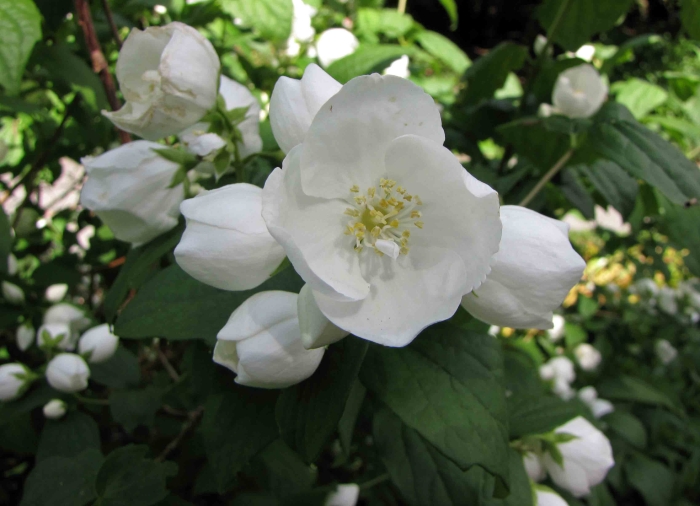Mock Orange
(Philadelphus ×virginalis)
Mock Orange (Philadelphus ×virginalis)
/
/

阿橋 HQ
CC BY-SA 2.0
Image By:
阿橋 HQ
Recorded By:
Copyright:
CC BY-SA 2.0
Copyright Notice:
Photo by: 阿橋 HQ | License Type: CC BY-SA 2.0 | License URL: https://creativecommons.org/licenses/by-sa/2.0 | Uploader: Rudolphous | Publisher: Wikipedia Commons |
































Estimated Native Range
Summary
Philadelphus ×virginalis, commonly known as Mock Orange or Virginal Mock Orange, is a deciduous perennial shrub that is an artificial hybrid created in 1909 by Victor Lemoine from crossing P. coronarius, P. microphyllus, and P. pubescens. It thrives in habitats including open woodlands and forest edges, particularly in regions where its parent species overlap. This shrub typically grows at a moderate rate to a height and width of 5-10 feet (1.5-3 meters). It features a dense, rounded form with arching branches and is covered in white, highly fragrant flowers that bloom profusely in late spring to early summer, making it particularly showy during this period.
Mock Orange is valued for its sweetly scented flowers that resemble orange blossoms, hence the name. It is often used in urban and suburban landscapes for border planting, as a specimen or in groups, and is also suitable for informal hedges. It thrives in full sun but can tolerate part shade, and prefers medium or fast-draining clay, loam, or sandy soils. While it requires medium amounts of water, once established, it is relatively drought-tolerant. Pruning after flowering helps maintain its shape and encourages more prolific blooming in the following season.CC BY-SA 4.0
Mock Orange is valued for its sweetly scented flowers that resemble orange blossoms, hence the name. It is often used in urban and suburban landscapes for border planting, as a specimen or in groups, and is also suitable for informal hedges. It thrives in full sun but can tolerate part shade, and prefers medium or fast-draining clay, loam, or sandy soils. While it requires medium amounts of water, once established, it is relatively drought-tolerant. Pruning after flowering helps maintain its shape and encourages more prolific blooming in the following season.CC BY-SA 4.0
Plant Description
- Plant Type: Shrubs
- Height: 5-10 feet
- Width: 5-10 feet
- Growth Rate: Moderate
- Flower Color: White
- Flowering Season: Spring, Summer
- Leaf Retention: Deciduous
Growth Requirements
- Sun: Full Sun
- Water: Medium
- Drainage: Fast, Medium
Common Uses
Bird Garden, Border Plant, Fragrant, Hedges, Low Maintenance, Showy Flowers, Street Planting
Natural Habitat
Open woodlands and forest edges
Other Names
Common Names: Virginal Mock Orange
Scientific Names: Philadelphus ×virginalis , Philadelphus xvirginalis
GBIF Accepted Name: